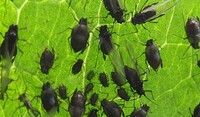
Wild oat control… this season’s hot TOPIK

TOPIK (240 g/L clodinafop-propargyl and 60 g/L cloquintocet-mexyl) provides good control of wild oats in cereals (as well as controlling rough meadow-grass and providing moderate control of susceptible Italian rye-grass) but must be used with care to achieve the required level of spray coverage, especially when targeting weeds which are shielded by a well-developed crop canopy.
Competing spray requirements (which often tempt growers and spray operators to use a reduce water volume in order to cover more ground within a specific window of opportunity) will reduce application coverage and can be counter-intuitive when tackling wild oats where getting the optimal biological efficacy from the herbicides being applied is essential.
Herbicides like TOPIK should therefore be applied in a way that ensures maximum spray coverage: if applied early in the spring when weeds are small and not shielded by the crop’s canopy, it is possible to use a reduced water volume (100 L/ha instead of 200 L/ha). However, for applications made beyond GS31 a water volume of at least 200 L/ha is recommended for most scenarios.*
Nozzle choice, boom height and forward operating speed will also have an impact on spray coverage, with the simple advice being to spray slowly (12pkh) at a sensible boom height (50cm above the canopy) and with an appropriate water volume (200l/ha) to optimise coverage of the target weeds.
TOPIK: application recommendations
Early spring applications (before GS31)
- Prior to GS31: small weeds sitting in an open crop canopy will be easier to target
- Water volume: 100 L/ha
- Maximum speed: 12 kph
- Nozzle: angled 3D nozzle for all-round coverage
- Boom height: 50cm above canopy
Late spring applications
- GS31-41: small weeds protected by a taller and thicker crop canopy
- Water volume: 200 L/ha*
- Maximum speed: 12 kph
- Nozzle: angled 3D nozzle for all-round coverage
- Boom height: 50cm above canopy
*There is some evidence to suggest that smaller droplets and a concentrated solution using 100 L/ha will perform well at the GS31-41 timing, but only if the wild oat plants are larger than the crop and therefore emerging above the crop canopy.
Irrespective of when it is used, TOPIK will perform best when applied during good growing conditions as this improves uptake: in 2021, the cold and dry spring conditions had a negative impact on the efficacy of all ACCase herbicides even when applied at the optimum timing for wild-oat activity. If unfavourable weather conditions delay treatments and allow weeds to become larger, consider using a higher rate of TOPIK applied without an adjuvant (the lack of an adjuvant is less of a concern when TOPIK is applied in a mix with other products that contain surfactants and which will aid leaf wetting).
TOPIK
240 g/L clodinafop-propargyl and 60 g/L cloquintocet-mexyl
Controls wild-oats, rough meadow-grass and gives moderate control of Italian rye-grass in wheat, durum wheat and triticale.
Optimum timing:
Wild-oats from 1 leaf unfolded up to flag leaf ligule visible.
Application rates:
0.25 L/ha
0.125 L/ha plus adjuvant (methylated seed oil)
Optimum weed control is best achieved when all the wild-oats have emerged and are actively growing in good conditions.


